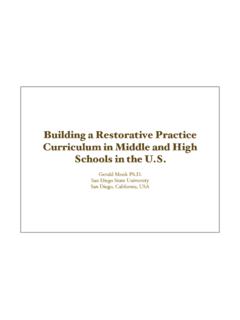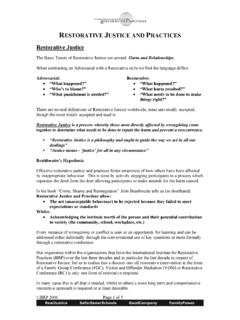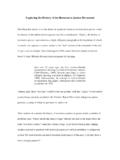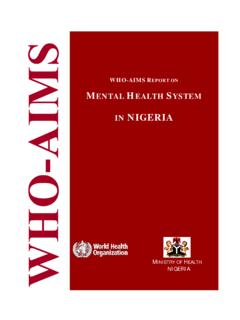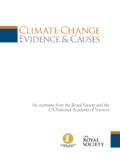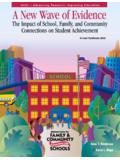Transcription of the evidence restorative justice - Home - IIRP …
1 The Smith InstituteThe Smith Institute is an independent think tank that has been set up to look at issues which flow from the changing relationship between social values and economic you would like to know more about the Smith Institute please write to:The DirectorThe Smith Institute3rd Floor52 Grosvenor GardensLondonSW1W 0 AWTelephone+44 (0)20 7823 4240 Fax+44 (0)20 7823 and produced by Owen & OwenBy Lawrence W Sherman and Heather Strangrestorative justice :the evidence2007restorative justice : the evidenceTHE SMITH INSTITUTEBy Lawrence W Sherman and Heather StrangJerry Lee Program of Randomized Trials in restorative JusticeIn collaboration withGeoffrey BarnesSarah BennettCaroline M AngelDorothy Newbury-BirchDaniel J WoodsCharlotte E GillPlease direct all correspondence note on formatThis report follows a modified UK Cabinet Office format of unpacking the content like a website: a one-page abstract, a three-page executive summary, and a detailed introductory sectionthat summarises the findings of the full report.
2 This format enablesthe users of the document to read or circulate either theabstract alone, the abstract plus the three-page executive summary, the abstract plus the introductory overview (section 1) of the full report, or the entire document. This format is designedto provide different levels of detail for different kinds of readers,and to support the different ways in which information is digestedfor different stages and levels of discussion and decision by the Smith InstituteISBN 1 905370 16 4 This report, like all Smith Institute monographs, represents the views of the authors and not those of the Smith Institute.
3 The Smith Institute 2007restorative justice : the evidence RJ_Text_FINAL 5/2/07 10:51 Page 1 THE SMITH INSTITUTE2 ContentsPrefaceBy Wilf Stevenson, Director, Smith InstituteAbstract About the authors ForewordBy Jerry Lee, President of the Jerry Lee Foundation AcknowledgementsExecutive summary 1. Introduction and overview Key findings: tables 1 to 52. A tale of three RJ conferences 3. Varieties of restorative justice 4. The process of restorative justice 5. restorative justice and the rule of law6. How we know what works and what doesn't 7.
4 restorative justice in the UK: the four settings Adult justice Youth justice Schools Neighbourhood policing8. Keeping promises versus following orders: how RJ compares9. Reducing harm to victims 10. Reducing repeat offending 11. Rare events: when RJ backfires and why 12. Other effects on crime 13. Getting cases brought to justice14. Could RJ reduce the financial costs of justice ?15. More justice , less crime: a way forwardBibliography345678122632364448525 86268747882868892RJ_Text_FINAL 5/2/07 10:51 Page 2 THE SMITH INSTITUTE3 PrefaceWilf Stevenson, Director, Smith InstituteThe Smith Institute is an independent think tank which has been set up to undertake research and education in issues thatflow from the changing relationship between social values andeconomic imperatives.
5 In recent years the institute has centredits work on the policy implications arising from the interactionsof equality, enterprise and 2004-05 the Smith Institute ran a highly successful series ofseminars looking at case studies of the use of restorative justicetechniques among criminals and their victims, in schools andwithin communities and neighbourhoods. Building on theimpressive accounts of how powerful restorative justice techniques could be, as a way both of changing behaviour and of mitigating harm, this independent report was commissionedby the Smith Institute in association with the Esm e FairbairnFoundation in order to examine the evidence on restorative justice (RJ) from Britain and around the world.
6 The aim of the project was to bring together the results of RJ trials in order to set out a definitive statement of what constitutes good-quality RJ, as well as to draw conclusions bothas to its effectiveness with particular reference to reoffendingand as to the role that RJ might play in the future of Britain syouth and criminal justice Smith Institute thanks Sir Charles Pollard, Rob Allen andProfessor Mike Hough for their hard work as members of thesteering committee convened to commission and oversee theacademic rigour of this Smith Institute gratefully acknowledges the support of theEsm e Fairbairn Foundation towards this 5/2/07 10:51 Page 34 THE SMITH INSTITUTEA bstractA review of research on restorative justice (RJ) in the UK andabroad shows that across 36 direct comparisons to conventionalcriminal justice (CJ), RJ has, in at least two tests each.
7 Substantially reduced repeat offending for some offenders,but not all; doubled (or more) the offences brought to justice as diversionfrom CJ; reduced crime victims post-traumatic stress symptoms andrelated costs; provided both victims and offenders with more satisfactionwith justice than CJ; reduced crime victims desire for violent revenge against theiroffenders; reduced the costs of criminal justice , when used as diversionfrom CJ; reduced recidivism more thanprison (adults) or as well asprison (youths).These conclusions are based largely on two forms of restorativejustice (RJ): face-to-face meetings among all parties connectedto a crime, including victims, offenders, their families and friends,and court-ordered financial restitution.
8 Most of the face-to-faceevidence is based on consistent use of police officers trained inthe same format for leading RJ discussions. These meetings have been tested in comparison with conventional criminaljustice (CJ) without benefit of RJ, at several stages of CJ forviolence and theft: as diversion from prosecution altogether (Australia and US); as a pre-sentencing, post-conviction add-on to thesentencing process; as a supplement to a community sentence (probation); as a preparation for release from long-term imprisonment toresettlement.
9 As a form of final warning to young crimesSix rigorous field tests found RJ reduced recidivism after adult oryouth violence. Three of these were randomised controlled trials(RCTs), conducted with youth under 30 in Canberra, femalesunder 18 in Northumbria, and (mostly) males under 14 inIndianapolis. Reasonable comparisons also show effects for adultmales in West Yorkshire and the West Midlands, as well as forviolent families in Canada. Property crimesFive tests of RJ have found reductions in recidivism afterproperty crime.
10 Four were RCTs done with youth: in Northumbria,Georgia, Washington and Indianapolis. Diversion of propertyoffenders to RJ, however, increased arrest rates among a smallsample of Aboriginals in benefitsTwo RCTs in London show that RJ reduces post-traumatic stress;in four RCTs RJ reduces desire for violent revenge; in four RCTsvictims prefer RJ over versus prisonIn Idaho an RCT of RJ as court-ordered restitution did no worsethan short jail sentences for youth. In Canada adults divertedfrom prison to RJ had lower reconviction rates than a matchedsample of inmates.



